![]()
![]()
![]()
Use LEFT and RIGHT arrow keys to navigate between flashcards;
Use UP and DOWN arrow keys to flip the card;
H to show hint;
A reads text to speech;
25 Cards in this Set
- Front
- Back
- 3rd side (hint)
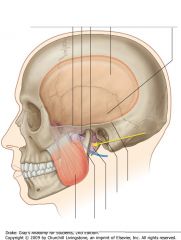
What is the pink region indicated by the yellow area?
|

The Infratemporal Fossa
|
|
|
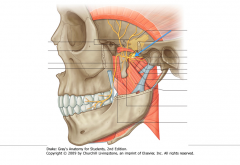
What nerve is indicated by the blue arrow?
|

The Mandibular Nerve (V3 of CN V)
|
|
|
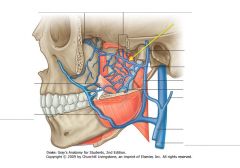
What veins are indicated by the yellow arrow?
|

The Pterygoid Plexus of veins.
|
|
|
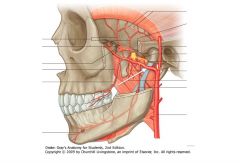
What is the artery indicated by the white arrow?
|

The Maxillary Artery
|
|
|
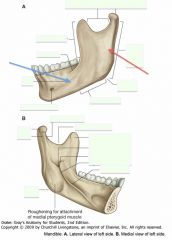
What part of the mandible is indicated by the red arrow?
What is indicated by the blue arrow? |

Red: Ramus
Blue: Body |
|
|
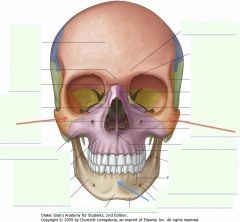
What is the ridge indicated by the blue arrow?
|

The Symphysis Menti
|
|
|

What portion of the Mandible is spanned (roughly) by the red arrows?
|

The Body
|
|
|
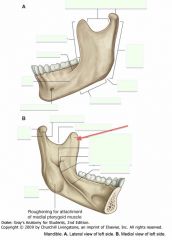
What portion of the Ramus is indicated by the red arrow?
What is its function? |

The Coronoid Process.
It provides attachment for the Temporalis Muscle. |
|
|
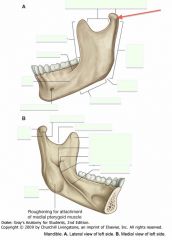
What is the part of the Ramus indicated by the red arrow?
What are its two parts called? What does it articulate with? |

The Condylar Process.
It consists of a Head and Neck (seen in lower view). The Head articulates with the mandibular fossa of the temporal bone to form the temporomandibular joint. |
|
|
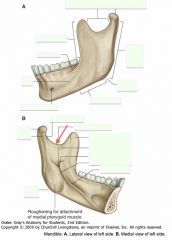
What is the feature indicated by the red arrow called?
|

The Mandibular Notch
|
|
|

Where is the Mandibular Fossa of the temporal bone?
|
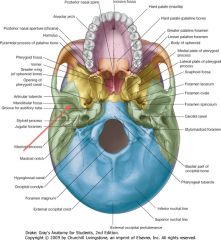
See the location of the red arrow.
|
|
|
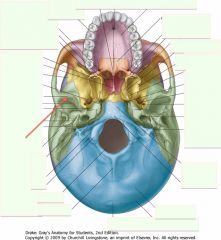
What feature of the Temporal Bone is indicated by the red arrow?
|

The Articular Eminence (or tubercle).
|
|
|
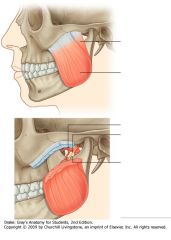
What muscle is indicated in this diagram?
What is it's primary function |

The Masseter Muscle
It elevates the Mandible. |
|
|
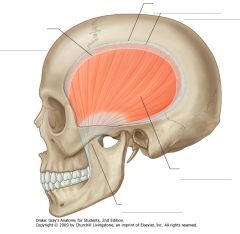
What muscle is shown in this diagram?
Where does it form attachment? |

The Temporalis Muscle
Superiorly on the Temporal Fossa; inferiorly on the Coronoid Process of the Mandible. |
|
|
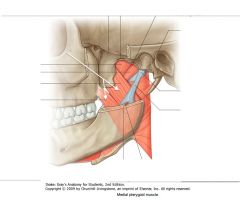
What muscle is indicated by the white arrow?
Where does it attach? |

The Medial Pterygoid Muscle
The deep head attaches to the medial surface of the lateral plate of the pterygoid process. The superficial head originates from the tuberosity of the maxilla. The two heads join to attach to the roughened medial surface of the ramus of the mandible (near the angle of the mandible). |
Both deep and superficial heads attach to the adjacent pyramidal process of the palatine bone.
|
|
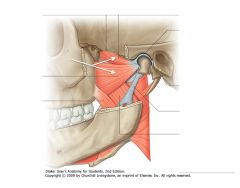
What muscle is indicated by the white arrows?
What action does it perform on the mandible? |

The Lateral Pterygoid Muscle.
The two heads act together to protrude the jaw. When the right and left act independently, they can produce a side to side movement of the jaw. |
|
|
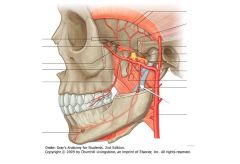
What artery is indicated by the white arrow?
What is it a branch of? |

Inferior Alveolar artery.
A branch of the Maxillary Artery. |
|
|

What artery is indicated by the white arrow?
What is it a branch of? |
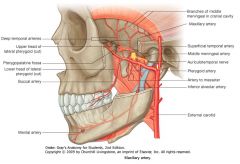
The Middle Meningeal Artery.
A branch of the Maxillary Artery. |
|
|
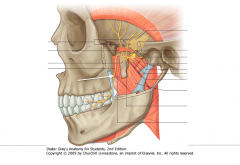
What nerve is indicated by the white arrow?
What is it a branch of? |

The Buccal Nerve
A branch of the Mandibular Nerve (V3) |
|
|
|
What is the primary function of the Buccal Nerve?
|

It is predominantly a sensory division of V3, but may also carry motor innervation to the lateral pterygoid muscle.
|
|
|
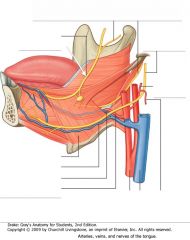
What nerve is indicated by the white arrow?
What does it innervate? |

The Lingual Nerve, a branch off of V3.
It carries general and special sensory fibres from the anterior 2/3 of the tongue. |
It carries the sensation to the Chorda tympani (From CN VII)
|
|

What nerve is indicated by the white arrow?
|
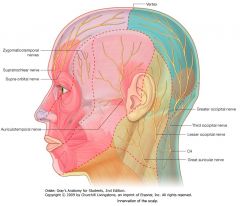
The Auriculotemporal Nerve, a branch off of the Mandibular Nerve (V3).
|
|
|
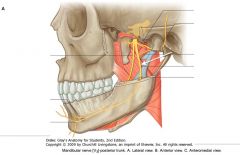
What nerve is indicated by the white arrow?
What foramen does it enter? |

The Inferior Alveolar Nerve, a branch off of the posterior Mandibular (V3).
It enters the Mandibular Foramen. |
|
|
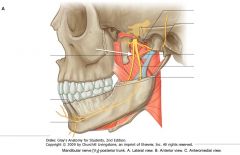
What nerve is indicated by the white arrow?
|

The Lingual Nerve, a sensory branch off of the posterior Mandibular Nerve (V3).
|
|
|
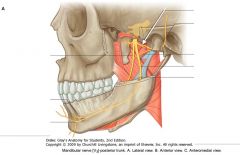
What nerve is indicated by the white arrow?
|

The Auriculotemporal Nerve, a sensory branch of the Mandibular Nerve (V3).
|
|

